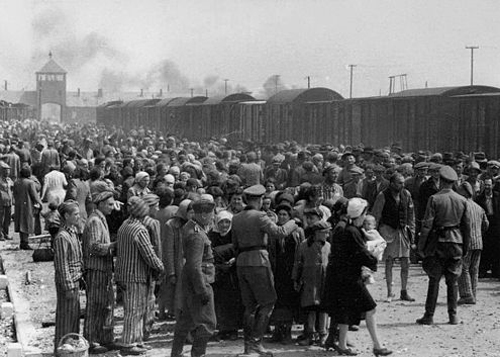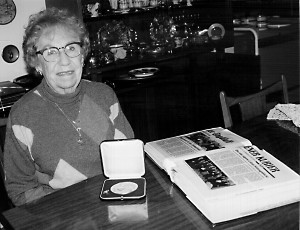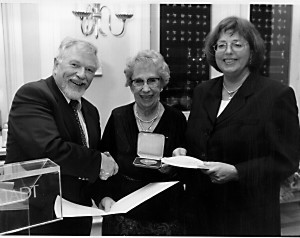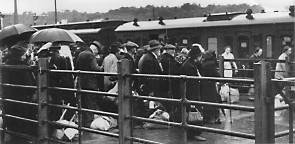
Eve Gerstle, 100, last known Jewish survivor of Wiesbaden
Editor’s Note: We received the unhappy news on Friday, October 23, 2015, that Eve Gerstle had died two days earlier. A Holocaust survivor who lived to see her 101st birthday, Gerstle was well-loved in her adopted San Diego community. In her memory, we reprint this story from Feb. 12, 1999 about how Gerstle was honored by the City of Wiesbaden as its last known living Holocaust survivor.
By Donald H. Harrison
SAN DIEGO — The city of Wiesbaden, Germany, recently honored San Diegan Eve Gerstle, 84, who had been deported from there to a Nazi concentration camp in 1942 and now is believed to be the German city’s last living Holocaust survivor.
 |
In a ceremony Dec. 12, Wiesbaden presented to Gerstle its gold medal, the highest award it can bestow upon a civilian. Presentations to other honorees, for various civic works, were medals of either bronze or silver.The letter of invitation sent to Gerstle by Wiesbaden’s Mayor Hildebrand Diehl closely paralleled the citation read at the ceremony in the German city’s city hall.
“You have after punishment and deportation during the Nazi regime and personal losses |
| Eve Gerstle, Wiesbaden’s last living Holocaust survivor |
made a life’s effort to teach mostly young people in the U.S.A. with lectures and discussions about the history of Wiesbaden during this terrible nazi regime, at the same time fighting against hatred and discrimination,” the mayor’s letter said.
“During your visit to Wiesbaden in 1985, you touched many people who had the pleasure of meeting you with your special outlook and warmth.”
In her speech accepting the award, Gerstle, who was born Eva Wertheimer, told the Germans that she had always “loved Wiesbaden very much, but it has for me two sides–one, light and pleasant; the other, dark and very ugly.”
 |
The light side, she said, “was being a student at the high school and going skiing in the Taunus Mountain, swimming at the Rhine River” playing tennis and dancing during her courtship with her first husband, Ari Zwick, who died in the Holocaust.But the beautiful scenes of her youth soon were overshadowed by the dark side, including “moving with my parents from our beautiful home into a ‘Jew House,’ which was where every Jewish family got one room and where, downstairs, an SS man checked the people going in and out to make sure that the Jewish star was sewn on and not pinned on.” |
| Eve Gerstle receiving medal |
Later, the dark side included “my working at forced labor at the chemical factory, and another factory after that, and then deportation Aug. 30, 1942 with my parents to Theresienstadt.” Her parents died in that ghetto (also called Terezin), and she was transferred to the Auschwitz-Birkenau concentration camp. From there she went to Stutthof, another death camp in Poland, where she survived until near the end of the war. With the Russians closing in, the Germans seeded a field with concentration camp inmates–making them sleep in what was expected to be the path of Russian tanks. When the Germans retreated, the inmates were forced to march back towards Germany, or be shot. At that point, Gerstle hid behind some shrubs with another Jewish woman then snuck off.
However, they were soon discovered by German soldiers and put into a jail. The next day, however, the Germans were gone. Gerstle and her companion walked out of the jail and promptly were arrested by the Russians who put them up against a wall for execution, thinking they were German collaborators. When her companion started praying Shm’a Yisrael , A Yiddish speaking Russian officer ordered the firing squad to put down the rifles.
Following the war, Gerstle returned to Wiesbaden, hoping to find members of her family or Jewish neighbors. None returned, she said. She remained in Wiesbaden for two years, sneaking one night into the Kurhaus to attend Friday night services being conducted for soldiers of the American occupation force who were Jewish. There she met Julius Gerstle, whom she married after immigrating to the United States.
Gerstle‘s husband died in 1989, but she was accompanied to last month’s ceremony by her daughter, Susi Page.
They stayed in the area a week, and one day visited the train station where Jews had been assembled for the deportation. Exhibits at the train station included photographs taken by a Nazi SS officer of the deportations.
 |
“Susi,” Gerstle suddenly shouted as she looked at the photograph. “That is me!”She pointed to a woman in white standing with her back to the train looking at older people, most of whom were bundled up against the rain in dark overcoats.
Gerstle said she had been in a Wiesbaden hospital when an earlier transport left with |
| Embarcation at Wiesbaden, Germany |
other people under 60 years of age. The doctor caring for her refused to release her to the Nazis. Following her release from the hospital, she was put in with a transport of older people, which went to Theresienstadt. The earlier transport had gone to some place in Poland, she said. The passengers never returned.